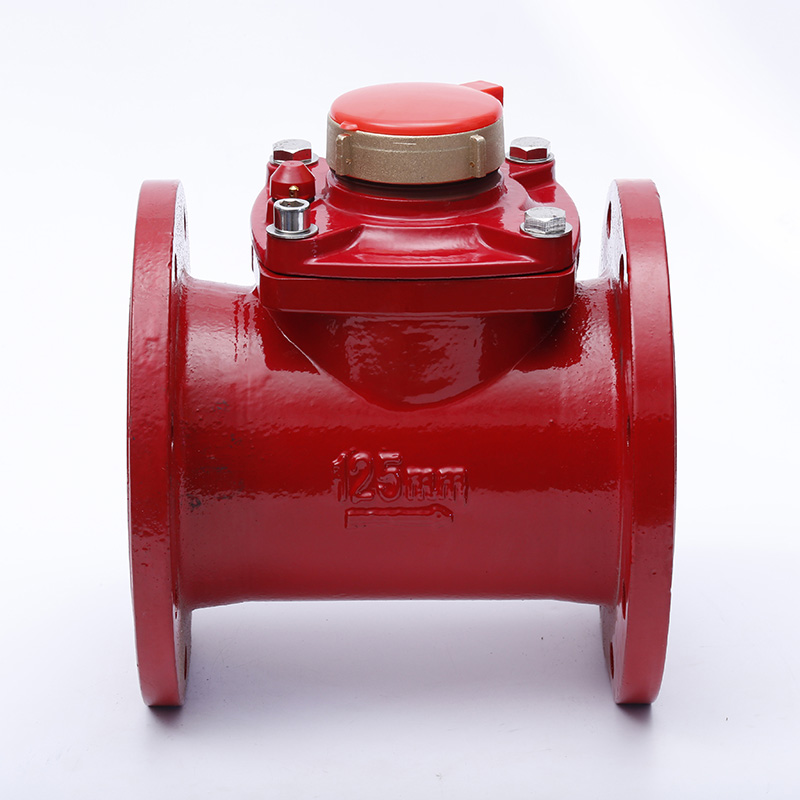
Propeller water meters, also known as Woltmann water meters, are a type of velocity-type water meter suitable for use in large-diameter pipes (DN80-DN200). They feature high flow capacity and low pressure loss. So, how do propeller water meters work? What are their different types?
Like rotary vane water meters (DN15-DN65), propeller water meters are also a type of velocity-type water meter. When water flows into the meter, it strikes the meter's propeller-shaped impeller along its axis, causing it to rotate and flow out. The impeller's speed is proportional to the water velocity. After passing through a reduction gear, the total amount of water passing through the meter is displayed on an indicator.
Propeller water meters are divided into two categories: horizontal and vertical. Most industrial meters used in China are horizontal propeller meters. In addition, the detachable horizontal propeller water meter (dry type) has also become one of the series of products and is popular among users because of its wide metering flow range, strong versatility of parts, and the ability to install and maintain without stopping the water supply or removing the meter.

| Characteristic/Parameter | Volute-Type Water Meter | Screw-Type Water Meter |
|---|---|---|
| Working Principle | Both rely on water flow impacting the impeller's rotation and then the gear deceleration mechanism to count the number of rotations for water consumption measurement. | Both rely on water flow impacting the impeller's rotation and then the gear deceleration mechanism to count the number of rotations for water consumption measurement. |
| Shaft Direction Relative to Flow | The rotation axis is perpendicular to the direction of water flow. | The rotation axis is parallel to the direction of water flow. |
| Impeller Mounting Method | Several radial rotating fins are mounted on the rotor. | Several helical fins are mounted on the rotor. |
| Measurement Accuracy | Higher measurement accuracy. | Lower measurement accuracy. |
| Pressure Drop | Likely to cause a significant pressure drop. | unlikely to cause a pressure drop. |
| Flow Capacity | Lower flow capacity. | Higher flow capacity. |
| Appearance | Common appearance with a slender middle section and tapered ends. | Consistent appearance, forming a straight line. |
| Application Field | More common in the market, suitable for places with smaller water demand such as residential areas and malls. | More suitable for industrial locations, agricultural irrigation, and large-scale water use locations, while being easier to maintain. |
Choose a suitable installation location: The water meter should be installed in a dry, well-ventilated room, away from direct sunlight and humidity to prevent deformation of the plastic components. Ensure that the pipe is fully filled with water, that air bubbles do not accumulate within the meter, and that it is not installed at the highest point in the pipe.
Pipeline Preparation: Install a straight pipe section with the same cross-section as the pipe, at least five times the meter diameter, at the water meter inlet. Install a straight pipe section at least two times the meter diameter at the water meter outlet. Ensure that the connecting pipes upstream and downstream of the water meter are not constricted, and that the water flow direction aligns with the flow direction of the pipe. Furthermore, the pipes should be free of debris to prevent damage to the water meter.
Installation of Valves and Filters: The water meter should be installed with a valve to facilitate removal and replacement. It is also recommended to install flow control devices (such as valves) and filters to protect the meter from impurities and water pressure shock.
Installation Specifications: The water meter must be installed in the specified orientation. For example, small-diameter rotary vane water meters must be installed horizontally. Tilting them forward, backward, or left, right, may reduce sensitivity. After installation, slowly drain water to fill the pipe to prevent high-speed airflow from damaging the meter. Calibration and inspection: Water meters should be calibrated before installation to ensure accurate measurement. After installation, the operation of the water meter should be checked regularly to ensure there are no faults.